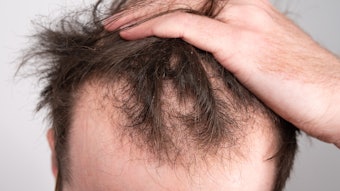Based on the fact that the orifices, or infundibulum, that surround human hairs constitute only 0.1% of the total surface area of human skin,1 one might predict this route of penetration to be of minor importance. However, on places of the human body where hair density is much higher such as the face, this local surface area can be much higher—as much as 10%.2 Combine this with the fact that the skin barrier is not as strong in the infundibulum as it is on the surface of the skin (see Figure 1), and it becomes clear that this route of entry into the skin cannot be ignored. During early days of skin delivery, transfollicular delivery of chemicals into and through skin was investigated but one of the main difficulties was the validity of the models available to investigate this route of entry. Three basic methods were used to investigate transfollicular delivery:
1.In the early 1990s, Hueber et al. developed a method in which skin was artificially scarred, resulting in the absence of hair follicles and sebaceous glands, the thinning of collagenous fibers with parallel orientation to the dermo-epidermal junction, and a decrease in the number or disappearance of elastic fibers.4 The skin penetration of four steroids: progesterone, testosterone, estradiol and hydrocortisone, was investigated and their levels of penetration were found to be significantly higher (1.7 to 3.1-fold) in normal skin than in scarred skin. From this, the authors concluded that human skin appendages, i.e., hair follicles and sebaceous glands, constituted a route of penetration for steroids and, likely, other chemicals of similar molecular weight and properties.4
Such papers were greeted with skepticism since the scarring process, which was often initiated via burning, also could have changed the barrier function of the remaining stratum corneum (SC). Aspects such as the lack of nutritional blood flow to the scarred tissue, however, were ruled out as the reason for the reduced skin penetration into scarred skin.5
2. Another approach used to investigate the contribution of the infundibulum to overall skin delivery was to compare the skin penetration of chemicals through newborn rat skin (24 hr) with that of five-day-old rat skin. Histological observations of newborn rat skin have shown that hair follicles are absent at birth but they form after three to four days of life. Comparison of the in vitro penetration of hydrocortisone through skin from rats sacrificed at24 hr and five days after birth demonstrated that the skin penetration rate—once a constant penetration rate or steady-state diffusion was achieved—was almost fivefold greater in the presence of intact follicular structures.6
But, skeptics argued, the barrier function of the skin is only just developing during its first days outside of the uterus, a transformation that is initiated by the change from an all-aqueous environment of amniotic fluid to a relatively arid, gaseous environment. So, does this observed difference in skin penetration represent only the contribution of the transfollicular pathway?
3. A less popular method of assessing the influence of the transfollicular pathway on skin delivery was to test the penetration of the same molecule from the same formulation through skin originating from different body sites with different hair follicle densities, then ascribing the observed differences in penetration to the contribution of additional hair follicles.7 Here, the skeptics could argue that ceramide composition and therefore skin barrier function also change with body site. Indeed, higher neutral lipid and lower sphingo-lipid levels were generally associated with superior barrier function.8
Another interesting paper from the 1990s was that of Rolland et al., which described the importance of size in transfollicular delivery.9 Researchers showed that polymeric microspheres with a mean diameter between 3 μm and 7 μm (see Figure 2) penetrated exclusively via the transfollicular pathway; however, whether this was real penetration or, in actuality, accumulation into the pilosebaceous unit and deeper dermal tissues could not be established.
At the end of the 20th century, the world of skin delivery scientists was divided between those who believed transfollicular delivery was important, and those who believed the available surface area was simply too small to be of any relevance. In the meantime, cosmetic scientists saw the relevance of transfollicular delivery for their products. After all, it would be beneficial to effectively deliver anti-acne products that target the sebaceous unit attached to the hair follicle (see Figure 1); or antiperspirants that target the eccrine gland or macromolecules (such as peptides and hyaluronic acid), for which the bulk of the SC is simply too efficient a barrier to allow penetration. Effective delivery of hair growth actives formed another business opportunity. Transfollicular delivery research became very quiet and scientists seemed to agree at least with the early words of Scheuplein, who in 1967 wrote10 that transfollicular delivery was limited to only the early phase of skin penetration before steady-state diffusion is achieved.
Research on transfollicular delivery all changed with the publication of an elegant and yet simple model for measuring transfollicular penetration—the skin sandwich model. Here, two adjacent pieces of SC from the same subject or animal were placed on top of each other. It was argued by Maghraby11 that the probability of two follicular orifices being superpositioned was low, and therefore, if no transfollicular penetration was observed, the skin penetration should be reduced by a factor of two because the thickness was increased by a factor of two. However, if transfollicular penetration took place, the skin penetration should be reduced by a factor greater than two (see Skin Sandwich Model). Using this technique, researchers could demonstrate that 47% of the mannitol that penetrated did so via the hair follicles.12 This time, the skeptics remained quiet since they could not beat the elegance and simplicity of the model.
Novel Methods and New Developments
Interest in transfollicular transport was revitalized at the beginning of this century when two groups independently began work again in this controversial field of skin delivery. First, Ylva Grams, PhD, and Joke Bouwstra, PhD, of the University of Leiden, Netherlands, started developing novel techniques to measure transfollicular delivery without testing scar tissue, the skin of newborn rats, or measuring different body sites where various mechanisms could explain the observed differences in penetration. The second group led by Jürgen Lademann, PhD, of the Charité-Universitätsmedizin Berlin, looked more at the physiological implications of transfollicular delivery, but also developed techniques to study skin penetration. These techniques, while technically cumbersome and challenging to conduct, provide useful information and will be described here before discussing the implications of the newly generated knowledge for the cosmetic industry.
Differential stripping, a combination of cyanoacrylate follicular biopsies and classical tape stripping: A novel method to specifically measure the contribution of transfollicular delivery is cyanoacrylate skin stripping. Cyanoacrylate stripping was first introduced in 1971 as a means of collecting skin surface samples to aid in dermatological diagnosis.13 This method involved applying a drop of liquid cyanoacrylate glue (superglue) to the surface of skin, and pressing a glass slide against it until the glue is dry. Subsequently, the glass slide is removed from the skin, bringing with it the SC and content of the upper follicle, to the depth the glue was able to penetrate.14 Using this technique, Bojar et al. demonstrated that the delivery of the anti-acne active azelaic acid from a topical formulation was sufficient to reach concentrations in the follicular cast to reduce the Propionibacterium acnes count.15
What was cumbersome about this method was physically separating the follicular cast from the bulk of the SC—until 2005 when Teichmann et al. developed a new method now known as differential stripping.16 After applying a test formulation to skin either in vivo or in vitro for a given period of time, the skin is stripped using the classic tape stripping technique. Subsequently, the same area is subjected to cyanoacrylate biopsy to remove the hair follicles—in this case, without contamination from drug or active ingredient content in the SC since these have already been removed. The cyanoacrylate casts can then be used to directly quantify the follicular contents. This method is schematically depicted in Figure 3. Using this technique, Lademann et al. were able to show that the hair follicles can act as a reservoir for topically applied nanoparticles and that these materials remain located in the hair follicles for a much longer time than in the SC (see Figure 4).17
Selective blocking of individualhair orifices by nail varnish: Teichmann et al. developed another seemingly simple yet time-consuming technique to measure transfollicular delivery: selectively blocking all hair follicles by applying nail varnish to the orifice of each. Segments of skin, where similar dots of nail varnish were placed adjacent to the hair follicle orifices, served as the control. When the experiment is performed in vivo, the two procedures are executed sequentially and therefore the site acts as its own control. Using a chemical UV filter as the model compound, the researchers were able to show different penetration and depth profiles with and without this selective blocking (see Figure 5),18 which also suggested that penetration took place via the interfollicular and transfollicular route.
Visual techniques: Since the ultimate evidence of anything is seeing it—after all, seeing is believing—many visualization techniques have been developed to demonstrate the presence of chemicals in the infundibulum. These include classical methodologies such as autoradiography (see Figure 6)19 and fluorescence microscopy, but these techniques involve cutting sections of the skin and one must be careful so as not to translocate the material being used to test penetration during the cutting process. On top of that, such pictures only provide a snapshot in time and therefore no kinetic information is obtained.
For this reason, Grams and Bouwstra developed a new technique that allows time- and depth-resolved images to be obtained.2, 20 When visualization techniques such as confocal scanning laser microscopy are employed in the usual way to measure the penetration of fluorescent chemicals into the skin, “light” is emitted from above the skin surface where it has entered the skin, scattered and reflected at a different wavelength; the deeper the chemicals have penetrated the skin, the weaker the reflected signal becomes.
This method does not allow for the quantification of the fluorescent chemical as a function of depth but it could if a skin section is viewed from the side, as shown in typical illustrations of skin cross sections, such as Figure 1. Therefore, the researchers made a drastic modification to this technique. In short, skin was cut perpendicular to the skin surface as closely as possible alongside a hair follicle. This sectioning was carried out in a special cutting device so that when a cover slip was placed on the cutting plane of the skin section, a donor and acceptor were created that were closed by means of dental clay and the same cover slip.
Immediately after assembling this on-line diffusion cell, the donor and acceptor phase were injected through the dental clay. A lipophilic fluorescent dye was included in the donor compartment and the skin and transfollicular penetration of the model dye could be followed on-line. Various resolutions were investigated, which allowed the penetration process of a fluorescent dye to be visualized as a function of time (see Figure 7).
Figure 7 shows that in the initial time period, the infundibulum and the cuticle of the hair follicle are stained very bright, and the fluorescence reaches deeper regions compared with the staining in the non-follicular route. In the infundibulum, the fluorescence intensity increases followed by a decrease up to the end of the experiment while the fluorescence intensity was strong in the cuticle and did not decrease. The epidermis is weakly labeled after 1 hr, whereas fluorescence enters the dermis after 2 hr but the fluorescence intensities in these non-follicular regions remain lower than the fluorescence intensities in the infundibulum and cuticle.
To explain it once again, close to the skin surface, the infundibulum and the cuticle of the hair follicle were stained at an early stage of the permeation process. This label, which reached the deeper layers in the cuticular region, permeated from the cuticle into the surrounding areas, namely the inner and outer root sheath. At a depth of up to 1,000 μm, diffusion via the follicular route (cuticle, outer root sheath) dominated the initial time period, while the staining penetrated the surrounding dermis afterward. At greater depths, the diffusion via the bulk of the dermis, rather than the infundibulum, gained more importance,21 which is in line with the predictions of Scheuplein more than 40 years ago.10 This was confirmed by the earlier staining of the subcutaneous fat as compared with the deeper parts of the hair follicle.
By this time, skin delivery scientists were united again and agreed that transfollicular transport is an essential part of skin delivery, and that it cannot be ignored. However, they still thought that transfollicular delivery was only important for active ingredients having medium to high lipophilicity,2 and particulate materials such as nanoparticles.
Implications for the Cosmetic Formulator
A few new insights have emerged from using these techniques that are relevant for the cosmetic formulator. These include the influence of massage and particle size on transfollicular delivery, and the influence of formulation components on transfollicular delivery from shampoos.
Massage and transfollicular delivery: While studying the influence of size on the transfollicular delivery of nanoparticles using the differential stripping method, Toll et al. found that only 60% of hair follicles participated in transfollicular penetration.22 The reason for this is that not all hair follicles are available for the uptake of particles. The availability for transfollicular penetration depends upon the conditions of application.23 If massage is applied during application, the hair follicles open up and skin penetration is statistically significantly enhanced—i.e., more and deeper.
What is happening during massage? Massage actually opens closed hair follicles. Follicles can be covered with corneocytes that have been shed and that act as plugs; these corneocytes can be pushed out of the follicle orifices by growing hairs or emerging sebum. Follicles normally open from sebum flow or hair growth, as has been shown by the penetration of dye whenever sebum secretion and/or hair growth occur.24 Tests have also revealed that when 74% of hair follicles on the upper forearm were open, followed by processes such as massaging and chemical peeling, this percentage increased to 100%.25
Particle size and transfollicular delivery: Figure 2 already indicated that size plays an important role for transfollicular delivery of particles in the micrometer range. It is now generally accepted that particles with a diameter greater than 15 μm are excluded from hair follicles, and that the optimal size for transfollicular delivery probably lies somewhere between 1.5 μm and 7 μm.9, 22 Particles in the 3–6 μm size range tend to aggregate around the follicular openings, whereas those of smaller sizes appear to have a much more even distribution across the surface of skin.14, 22 In fact, the infundibulum of the hair is working on a size-exclusion basis.
For nanoparticles, the situation is slightly different—the smaller the particles, the better they penetrate into skin via the transfollicular route. Figure 8 shows the cumulative penetration profiles of micro- and nanospheres of different sizes at different depths (as measured via differential stripping).22 This is of particular importance for nano-technological applications in cosmetic products, such as ultrafine particles of TiO2 and ZnO. These materials are used in sun care and have been shown to accumulate in the infundibulum, although they have not been shown to penetrate any further.16, 26 The smaller the particles, the deeper they penetrate into the infundibulum but this is in contrast to what is shown in Figure 7 for solubilized molecules where there is not further diffusion from the gap into the surrounding tissue.
Formulation components and transfollicular delivery: The lipophilic nature of sebum and the ability of formulations to mix with these secretions has been suggested as the reason why lipophilic vehicles, solvents and formulas with additional surfactants (wetting agents) appear to be superior to hydrophilic formulations in targeting follicular delivery.14 However, what can be said about the active itself? Grams et al.27 studied the transfollicular penetration of three dyes of increasing lipophilicity in a citric acid buffer, surfactants in a citric acid buffer, or surfactants/propylene glycol in a citric acid buffer. They concluded that targeting to the hair follicle can be increased by the use of lipophilic active ingredients in combination with surfactant solutions such as shampoos and propylene glycol.27
This suggests that hydrophilic molecules do not penetrate via this transfollicular route but this is not true. Jacobi et al.,28 for instance, found that the hydrophilic dye Patent blue V
was detected deeper in the SC than the lipophilic curcumin from the same formulation. In their most recent study, Otberg et al. measured the total skin penetration of caffeine through the chest skin of six volunteers with and without blocking their follicles by applying nail varnish,29 as described earlier.18
Caffeine has an octanol/water partition coefficient of -0.01 and is therefore often used as a model hydrophilic chemical in skin penetration studies. The researchers found significantly faster and better penetration of caffeine when the follicles were not blocked, indicating that polar chemicals also use this route as a port of entry into the skin, especially in the initial time period of penetration.29 The same technique was also used in combination with delivery of caffeine from shampoos in vivo. Similar results were obtained as with the previous study after a short application time—as short as only 2 min.30
Determining in vitro testing
relevance: An important implication of this work is that it raises questions about the relevance of doing skin penetration work in in vitro skin penetration cells. In these experiments, a formulation is pipetted onto the skin and left to penetrate for a defined period of time. In real life, however, consumers apply cosmetic products and rub them into their skin, which causes the formulation to break down or transform otherwise.31 If this opens up the hair follicles that otherwise would remain closed in experimental in vitro set-ups, this suggests that skin penetration in vivo might be higher than in vitro. Likewise, other mechanical manipulations such as flexing the skin have recently been shown to enhance skin penetration.32
On the other hand, while sebum flow and the growth of follicles help to keep hair follicles open, they also provide an upstream current for chemicals diffusing into the infundibulum, making it more difficult for molecules to penetrate via this route. For that reason, in vivo skin penetration studies should always be preferred rather than in vitro studies, but in vivo studies are argued to be very expensive.
Again, assistance may be found in recently developed measuring techniques. In order to assess the real in vivo penetration of a chemical from a formulation shortly after application and in a consumer-relevant manner, two techniques are useful that rely on different analytical principles. The first is attenuated total reflectance Fourier transformed infrared spectroscopy (ATR-FTIR). This measures very superficially the presence of an active within the skin. Provided the active molecule of interest has some absorbing groups, at frequencies where neither skin itself nor any other components of the formulation do not absorb, this technique can be used to assess semiquantitatively the influx of chemical into the skin.
A second technique that may be used is confocal Raman microspectroscopy, which has recently been used to measure the skin penetration of menthol, caffeine and ethylhexyl methoxycinnamate.32 Ethylhexyl methoxycinnamate was especially shown to penetrate human skin very rapidly in vivo; it also was shown to penetrate deep into the SC within minutes after application. This likely occurred via the transfollicular route and it would be of interest to combine the blocking method with confocal Raman microscopy to test this.
With some data manipulation, the latter technique can also be used semiquantitatively. Both techniques have the advantage of measuring skin penetration noninvasively in vivo and following real life application conditions, which would therefore indicate the delivery that may be encountered from cosmetic products.
A final implication of the fact that hair follicles play an important role in skin delivery is that future anti-acne, deodorant and hair growth products could become much more effective. Applying the knowledge of the penetration pathway with the right skin delivery system and formulation to target the follicular orifice will greatly enhance the efficacy of such products.
Conclusion
It is clear that transfollicular penetration can no longer be ignored. Whereas the old techniques to measure it had drawbacks, leaving other interpretations possible, the painstaking work of the groups of Bouwstra and, in particular, Lademann, have made it clear that this penetration route is of importance to the penetration of both hydrophilic and lipophilic molecules, in particular in the initial time period of skin penetration.
The reason why skin delivery scientists may have missed this in the past is the fact that hair follicles tend to open, therefore making them available for skin penetration, when there is a movement of the hair, i.e., massage, flexing or hair growth, as well as during sebum production. Since all these phenomena do not take place in the in vitro experimental set-ups of skin penetration cells, the cosmetic industry should use in vivo methods wherever possible, especially when the transfollicular route is suspected to be of importance.
In addition, these discoveries offer new product opportunities for anti-acne, hair loss and deodorant applications, especially in the area of particulate materials.
References
1. H Schaefer and TE Redelmeier, Skin Barrier, Principles of Percutaneous Absorption, Basel, Switzerland: Karger (1996)
2. YY Grams, JW Wiechers and JA Bouwstra, Novel ways of measuring the transfollicular transport of active ingredients across the skin, in: JW Wiechers (ed), Science and Applications of Skin Delivery Systems, Carol Stream, IL, USA: Allured Business Media, 24 425–440 (2008)
3. www.tgfolk.net/sites/gtg/hair_root.gif (accessed Sep 27, 2008)
4. A Hueber, H Schaefer and J Wepierre, Role of transepidermal and transfollicular routes in percutaneous absorption of steroids: In vitro studies on human skin, Skin Pharmacol 7 237–244 (1994)
5. A Hueber, M Besnard, H Schaefer and J Wepierre, Percutaneous absorption of estradiol and progesterone in normal and appendage-free skin of the hairless rat: Lack of importance of nutritional blood flow, Skin Pharmacol 7 245–256 (1994)
6. B Illel, H Schaefer, J Wepierre and O Doucet, Follicles play an important role in percutaneous absorption, J Pharm Sci 80 424–427 (1991)
7. E Tur, HI Maibach and R Guy, Percutaneous penetration of methyl nicotinate at three anatomic sites: Evidence for an appendageal contribution to transport? Skin Pharmacol 4 230–234 (1991)
8. MA Lampe et al, Human stratum corneum lipids: Characterization and regional variations, J Lipid Res 24 120–130 (1983)
9. A Rolland, N Wagner, A Chatelus, B Shroot and H Schaefer, Site-specific drug delivery to pilosebaceous structures using polymeric microspheres, Pharm Res 10 1738–1744 (1993)
10.RJ Scheuplein, Mechanism of percutaneous absorption. II. Transient diffusion and the relative importance of various routes of skin penetration, J Invest Dermatol 48 79–88 (1967)
11.GMM El Maghraby, AC Williams and BW Barry, Skin hydration and possible shunt route penetration in controlled oestradiol delivery from ultradeformable liposomes, J Pharm Pharmacol 53(10) 1311–1322 (2001)
12. EA Essa, MC Bonner and BW Barry, Human skin sandwich for assessing shunt route penetration during passive and iontophoretic drug and liposome delivery, J Pharm Pharmacol 54 1481–1490 (2002)
13. R Marks and RPR Dawber, Skin surface biopsy: An improved technique for the examination of the horny layer, Br J Dermatol 84 117–123 (1971)
14. S Cross, Significance of follicular delivery and ways to measure it, in: JW Wiechers (ed), Science and Applications of Skin Delivery Systems, Carol Stream, IL, USA: Allured Business Media 25, 441–459 (2008)
15. RA Bojar, AG Cutcliffe, K Graupe, WJ Cunliffe and KT Holland, Follicular concentrations of azelaic acid after a single topical application, Br J Dermatol 129 399–402 (1993)
16. A Teichmann et al, Differential stripping: Determination of the amount of topically applied substances penetrated into the hair follicles, J Invest Dermatol 125 264–269 (2005)
17. J Lademann et al, Hair follicles—A long-term reservoir for drug delivery, Skin Pharmacol Physiol 19 232–236 (2006)
18. A Teichmann, N Otberg, U Jacobi, W Sterry and J Lademann, Follicular penetration: Development of a methods to block the follicles selectively against the penetration of topically applied substances, Skin Pharmacol Physiol 19 216–223 (2006)
19. JW Wiechers, AV Rawlings, N Lindner and WJ Cunliffe, Treating acne with octadecenedioic acid: Mechanism of action, skin delivery, and clinical results, in: GF Webster and AV Rawlings (eds), Acne and its Therapy, New York: Informa Healthcare 12 137–154 (2007)
20. YY Grams, L Whitehead, P Cornwelland JA Bouwstra, Time and depth resolved visualisation of the diffusion of a lipophilic dye into the hair follicle of fresh unfixed human scalp skin, J Contr Rel 98 367–374 (2004)
21. YY Grams, L Whitehead, G Lamers, N Stuurman and JA Bouwstra, On-line diffusion profile of lipophilic model dye in different depths of a hair follicle in human scalp skin, J Invest Dermatol 125 775–782 (2005)
22. R Toll, U Jacobi, H Richter, J Lademann, U Schaefer and U Blume-Peytavi, Penetration profile of microspheres in follicular targeting of terminal hair follicles, J Invest Dermatol 123 168–176 (2004)
23. J Lademann et al, Nanoparticles—An efficient carrier for drug delivery into hair follicles, Eur J Pharm Biopharm 66 159–164 (2007)
24. J Lademann et al, Hair follicles—An efficient storage and penetration pathway for topically applied substances, Skin Pharmacol Physiol 21 150–155 (2008)
25. N Otberg, H Richter, A Knuttel, H Schaefer, W Sterry and J Lademann, Laser spectroscopic methods for the characterization of open and closed follicles, Laser Phys Letters, 1 46–49 (2004)
26. GJ Nohynek, J Lademann, C Ribaud and MS Roberts, Grey goo on the skin? Nanotechnology, cosmetic and sunscreen safety, Crit Rev Toxicol 37 251–277 (2007)
27. YY Grams, S Alaruikka, L Lashley, J Caussin, L Whitehead and JA Bouwstra, Permeant lipophilicity and vehicle composition influence accumulation of dyes in hair follicles of human skin, Eur J Pharm Sci 18 329–336 (2003)
28. U Jacobi, T Tassopoulos, C Surber and J Lademann, Cutaneous distribution and localisation of dyes affected by vehicles all with different lipophilicity, Arch Dermatol Res 297 303–310 (2006)
29. N Otberg et al, The role of hair follicles in the percutaneous absorption of caffeine, Br J Clin Pharmacol 65 488–492 (2008)
30.N Otberg, A Teichmann, U Rasuljev, R Sinkgraven, W Sterry and J Lademann, Follicular penetration of topically applied caffeine via a shampoo formulation, Skin Pharmacol Physiol 20 195–198 (2007)
31. J Zhang, EW Smith and C Surber, Galenic principles in skin protection, in: S Schliemann and P Elsner (eds) Skin Protection—Practical Applications in the Occupational Setting, Basel, Switzerland: Karger 11–18 (2007)
32. LW Zhang and NA Monteiro-Riviere, Assessment of quantum dot penetration into intact, tape-stripped, abraded and flexed rat skin, Skin Pharmacol Physiol 21 166–180 (2008)
33. PJ Caspers, A van der Pol and J de Sterke, Raman spectroscopy: A convenient non-invasive method for monitoring cosmetic and pharmaceutical ingredients into the skin, Int J Cosmet Sci 29 220–22 (2007)










